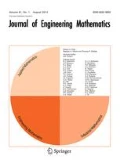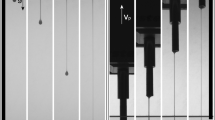Abstract
Papageorgiou derived a similarity solution that describes the asymptotic behavior of a thinning viscous thread suspended in vacuum, near the critical time and around the location of breakup. The motion is driven by surface tension, and the fluid inertia is neglected throughout the evolution. To assess the physical relevance of the similarity solution, the evolution of an infinite thread immersed in an ambient fluid with arbitrary viscosity, subject to periodic axisymmetrtic perturbations is simulated through solution of the equations of Stokes flow by a boundary integral method. The results show that when the thread is suspended in vacuum, the similarity solution accurately describes the process of thinning over an extended length of the thread between the developing bulges, and captures the late stages of breakup for a broad range of initial conditions. But a small amount of ambient fluid viscosity, as small as 0.05 times the viscosity of the thread fluid, drastically alters the nature of the motion by shifting the location of the breakup points toward the bases of developing bulges, and causing the thread to develop locally asymmetric shapes.
Similar content being viewed by others
References
M. Tjahjadi and J. M. Ottino, Stretching and breakup of droplets in chaotic flows. J. Fluid Mech. 232 (1991) 191-219.
A. H. P. Skelland and P. G. Walker, The effects of surface active agents on jet breakup in liquid-liquid systems. Can. J. Chem. Eng. 67 (1989) 762-770.
A. H. P. Skelland and E. A. Slaymaker, Effects of surface-active agents on drop size in liquid-liquid systems. Ind. Eng. Chem. Res. 29 (1990) 494-499.
D. B. Bogy, Drop formation in a circular liquid jet. Ann. Rev. Fluid Mech. 11 (1979) 207-228.
R. R. Allen, J. D. Meyer, and W. R. Knight, Thermodynamics and hydrodynamics of thermal ink jets. Hewlett-Packard Journal, May issue (1985) 221-227.
D. M. Henderson, W. G. Pritchard, and L. B. Smolka, On the pinch-off of a pendant drop of viscous fluid. Phys. Fluids 9 (1997) 3188-3200.
C. V. Boys Soap Bubbles. New York: Dover (1959) 192 pp.
J. Eggers, Nonlinear dynamics and breakup of free-surface flows. Rev. Modern Phys. 69 (1997) 865-930.
S. P. Lin and R. D. Reitz, Drop and spray formation from a liquid jet. Annu. Rev. Fluid Mech. 30 (1998) 85-105.
J. Plateau Statique Experimentale et Theoretique des Liquides Soumis aux Seules Forces Moleculaires. Paris: Gautier-Villars (1873) 495 pp.
L. Rayleigh, On the instability of jets. Proc. London Math. Soc. 10 (1878) 4-13.
L. Rayleigh, On the stability of a cylinder of viscous liquid under capillary force Phil. Mag. 34 (1892) 145.
Z. Z. Weber, Zum Zerfall eines Flüssigkeitsstrahles, Z. Math. Mech. 11 (1931) 136-154.
S. Tomotika, On the instability of a cylindrical thread of a viscous liquid surrounded by another viscous fluid. Proc. Roy. Soc. A 150 (1935) 322-337.
S. L. Goren, The instability of an annular layer thread of fluid. J. Fluid Mech. 13 (1962) 309-319.
S. L. Goren, The shape of a thread of liquid undergoing breakup. J. Colloid Sci. 19 (1964) 81-86.
L. A. Newhouse and C. Pozrikidis, The capillary instability of annular layers and liquid threads. J. Fluid Mech. 242 (1992) 193-209.
F. D. Rumscheidt and S. G. Mason, Break-up of stationary liquid threads. J. Colloid Sci. 17 (1962) 260-269.
P. H. M. Elemans, J. M. H. Janssen, and, H. E. H. Meijer, The measurement of interfacial tension in polymer/polymer systems: The breaking thread method. J. Rheol. 34 (1990) 1311-1325.
J. M. H. Janssen, Dynamics of liquid-liquid mixing. Doctoral Dissertation, Technische Universiteit Eindhoven, The Netherlands (1993) 117 pp.
D. T. Papageorgiou, Description of jet breakup. In: Y. Y. Renardy, A. C. Coward, D. T. Papageorgiou and S. M. Sun (eds), Adv. Multi-Fluid Flows. Philadelphia: SIAM (1996).
H. C. Lee, Drop formation in a liquid jet. IBM J. Res. Dev. 18 (1974) 364-369.
M. Renardy, Some comments on the surface-tension driven break-up (or the lack of it) of viscoelastic jets. J. Non-Newt. Fluid Mech. 51 (1994) 97-107.
J. Eggers, Universal pinching of 3D axisymmetric free-surface flow. Phys. Rev. Letters 71 (1993) 3458-3460.
D. T. Papageorgiou, On the breakup of viscous liquid threads. Phys. Fluids 7 (1995) 1529-1544.
M. Renardy, A numerical study of the asymptotic evolution and breakup of Newtonian and viscoelastic jets. J. Non-Newt. Fluid Mech. 51 (1995) 97-107.
M. P. Brenner, J. R. Lister, and H. A. Stone, Pinching threads, singularities and the number 0.0304... Phys. Fluids 8 (1996) 2827-2836.
D. W. Bousfield, R. Keunings, G. Marrucci and M. M. Denn, Nonlinear analysis of the surface tension driven breakup of viscoelastic filaments. J. Non-Newt. Fluid Mech. 21 (1986) 79-97.
N. N. Mansour and T. S. Lundgren, Satellite formation in capillary jet breakup. Phys. Fluids A 2 (1990) 1141-1144.
M. H. Tjahjadi, H. A. Stone, and J. M. Ottino, Satellite and subsatellite formation in capillary breakup. J. Fluid Mech. 243 (1992) 297-317.
J. R. Richards, A. M. Lenhoff, and A. N. Beris, Dynamic breakup of liquid-liquid jets. Phys. Fluids 6 (1994) 2640-2655.
J. R. Richards, A. N. Beris, and A. M. Lenhoff, Drop formation in liquid-liquid systems before and after jetting. Phys. Fluids 7 (1995) 2617-2630.
J. R. Lister, and H. A. Stone, Capillary breakup of a viscous thread surrounded by another viscous fluid. Phys. Fluids 10 (1998) 2758-2764.
J. M. Rallison and A. Acrivos, A numerical study of the deformation and burst of a viscous drop in an extensional flow. J. Fluid Mech. 89 (1978) 191-200.
C. Pozrikidis, Boundary Integral and Singularity Methods for Linearized Viscous Flow. Cambridge: Cambridge University Press (1992) 259 pp.
C. Pozrikidis, Numerical Computation in Science and Engineering. Oxford: Oxford University Press (1998) 627 pp.
T. A. Kowalewski, On the separation of droplets from a liquid jet. Fluid Dyn. Res. 17 (1996) 121-145.
S. Tomotika, Breakup of a drop of viscous liquid immersed in another viscous fluid which is extending at a uniform rate. Proc. Roy. Soc. A 153 (1936) 302-318.
T. Mikami, R. G. Cox, and S. G. Mason, Breakup of extending liquid threads. Int. J. Multiphase Flow 2 (1975) 113-138.
Author information
Authors and Affiliations
Rights and permissions
About this article
Cite this article
Pozrikidis, C. Capillary instability and breakup of a viscous thread. Journal of Engineering Mathematics 36, 255–275 (1999). https://doi.org/10.1023/A:1004564301235
Issue Date:
DOI: https://doi.org/10.1023/A:1004564301235




